KCSE Past Papers Woodwork 2013
Click Here - Free KCSE Past Papers » KCSE Past Papers Woodwork 2013 » Free Downloads » KCSE Papers & Marking Schemes
4.2.1 Woodwork Paper 1 (444/1)
SECTION A (40 marks)
Answer all the questions in this section in this spaces provided.
1(a) List two levels of qualifications of Technical Personnel in the woodwork industry. (2 marks)
(b) State four factors that determine the appearance of grains in timber. (2 marks)
2. Sketch and label a wing divider. (4 marks)
3. With the aid of sketches differentiate between chamfering and rounding as used in shaping. (4 marks)
4. Describe the following terms as used in timber: (4 marks)
(a) texture;
(b) figure.
5. State two functions of a jointer. (2 marks)
Fill column 2 with the appropriate class of fire. (2 marks)
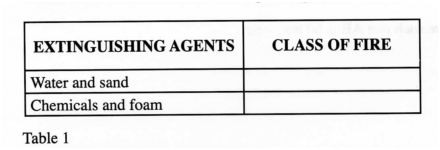
Classify the following types of pencils as either soft, medium or hard: 4H, 3B, B, I-IB, 2B, 2H. (3 marks)

(a) Rebated tongue and groove joint; (2 marks)
(b) Splayed butt joint. (2 marks)
8. State three precautions to be observed to ensure that there is no damage to a saw blade when in use. (3 marks)
9. Sketch the following types of bits and state the function of each.
(a) fiat bit; (2 marks)
(b) countersink bit. (2 marks)
10. Figure 1 shows a polygon ABCDE.
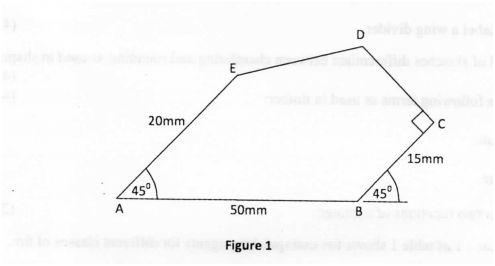
SECTION B (60 marks)
Answer question 11 on A1l paper provided and any the questions from this section in the spaces provided ajrer question 5. Candidates are adviced to spend more than 25 minutes on question 11.
11 . Figure 2 shows a shaped block.
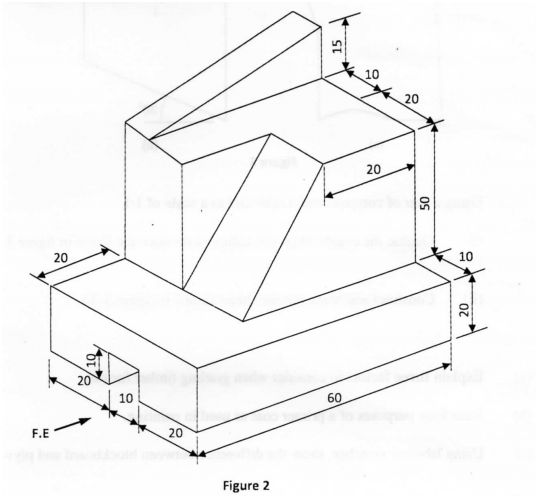
12. (a) State three precautions to be observed when using a steel tape measure. (3 marks)
(b) Figure 3 (a) shows a surface of an irregular wooden block.

Using a pair of compass and a ruler and to a scale of lzlv (i) Outline the construction procedure to produce the shape in figure 3 (b). (7 marks)
(ii) Construct and mark out the shape shown in figure 3 (b). (5 marks)
13. (a) Explain three factors to consider when grading timber for use. (5 marks)
(b) State four purposes of a primer coat as used in painting. (4 marks)
(c) Using labelled sketches, show the difference between blockboard and plywood. (6 marks)
14. (a) State six benefits of starting a small scale business in rural areas. (6 marks)
(b) Figure 4 shows pictorial views of wall mounted shelf. All members are 22 mm thick softwood.
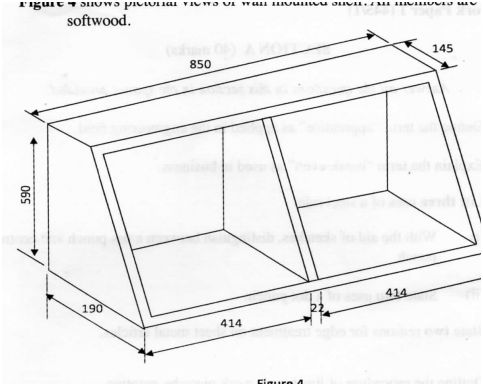
15 (a) With the aid of labelled sketches, describe the ripping and cross cutting operations on a piece of timber. (8 marks)
(b) State two advantages and two disadvantages of quarter sawing method of timber conversion. (4 marks)
(c) List three precautions to be observed to prevent splitting the work piece when making a hole using a chisel. (3 marks)
5.2 WOODWORK (444)
5.2.1 Woodwork Paper 1 (444/1)
1. (a) Levels of qualifications.
- Artisan
- Craftsman
- Technician
- Engineer
(b) Factors which determine the appearance of grains.
- Methods of cut.
- The location of the cut.
- The condition of wood.
- The arrangement of wood cells.
- Direction of cut.
2.
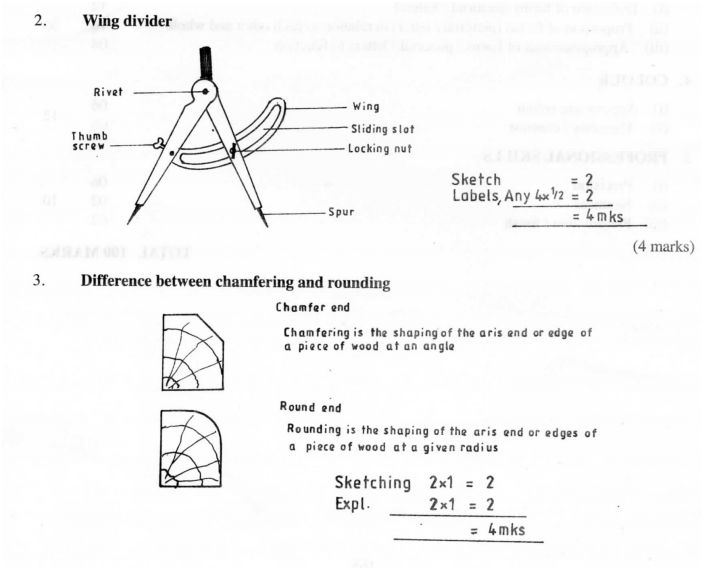
b) Figure - pattem 2 or markings which are formed 2 on the surface of processed timber as a result of wood tissue being cut 2 through.
2 x 2 = (4 marks) 5 a) Functions of a jointer
Makes edges straight and square.
Makes rebates, tongues and chamfers.
b)
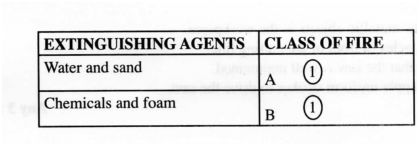
Crystal clear
Fast drying
Produce hazardous fumes during application
Can be sprayed or brushed
Do not form layers as thick as most varnishes.
b) Classification of pencils
Soft Medium Hard

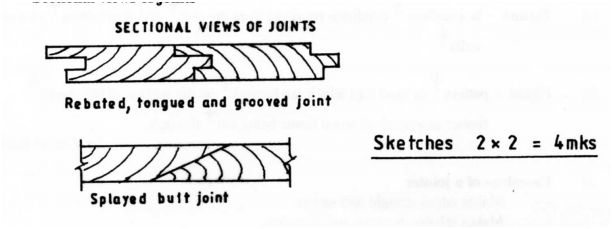
- No nailsl metallic objects in the workpiece.
- No obstacles in front of the cutting line.
- Ensure that the saw is well maintained.
- Make! apply uniform strokes to drive the saw.
9.
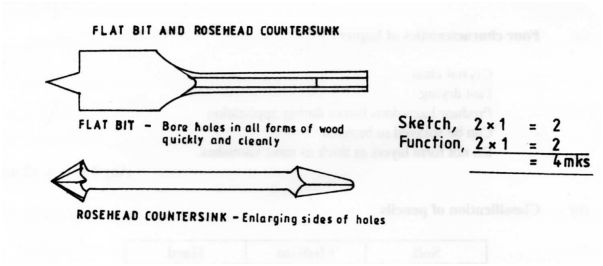
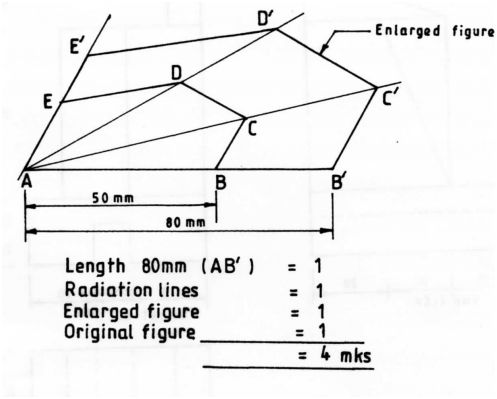
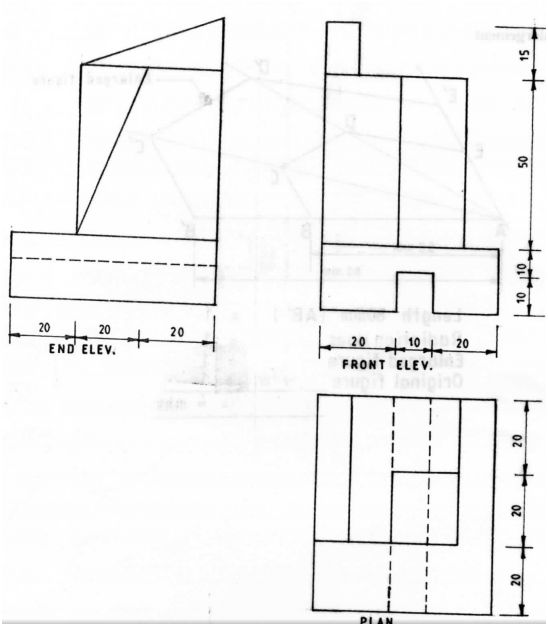
served when using a steel tape measure.
Do not pull or push the tape when the locking device is engaged C . . .
heck the accuracy with a vemler calllper to ensure the hook at the end is not bend.
D0 not extend the tape beyond its limits.
Do not drop the tape.
3x1 = (3 marks)
(i)
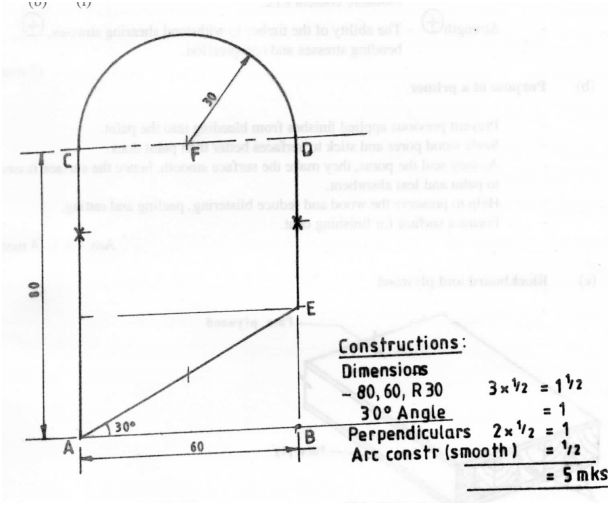
Establish line AB = 60 mm
At point A and B construct perpendicular lines.
At point A and B and along the perpendicular line, mark 80 nun - C and D
At point A construct L30“ to cut at E.
Measure 30 mm from point E to establish point F.
At point F construct an arc 30 mm radius to meet at C and D.
Join points A, C, D and E to produce the desired shape. 7 x 1 = (7 marks)
13. (a) Factors to consider when grading timber.
- Quality@ - when '1idging the qtéfity the grader considers the type , size and numbe of defects on the face (i.e) natural defect, sawing defect, seasoning e.t.c.
- Condition@ - The grader should consider the condition of the surface (i.e) staining@, discolouration® due to weathering, fungi attack@ moisture content e.t.c.
- Snengm@ - The ability of the timber to withstand shearing stresses, G9 bending stresses and compression. (5 marks)
(b) Purpose of a primer
- Prevent previous applied finishes from bleeding into the paint.
- Seals wood pores and stick to surfaces better than paint does.
- As they seal the pores, they make the surface smooth, hence the surface is easier to paint and less absorbent.
- Help to preserve the wood and reduce blistering, peeling and ratting.
- Forms a surface for finishing coat.
Any 4 x 1 (4 marks)
(c) Blockboard and plywood
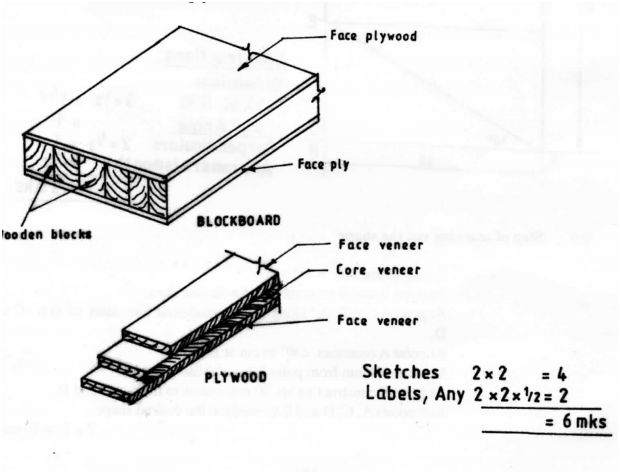
- Creates employment to the local community.
- Control the mral urban migration
- Generates revenue to the local authority by paying levies.
- Takes services closure to the people.
- Improves the living standards of the local community.
- Makes use of the locally available materials.
- Creates taxable revenue to the Government.
Any 6 xl = (6 marks)
(b) Cutting list
Item No. Description Size (mm) No. Off
1 Top 25 x 150 x 900 1 =
2 Bottom 25 x 200 x 900 1 =
Sides 25 x 200 x 600 =
Partition 25 x 200 x 600 =
EQ;-ma; = 1
Cross-cutting is the an of cutting
wood across the grains using
Sew kerb
Saw hr!
15. a)
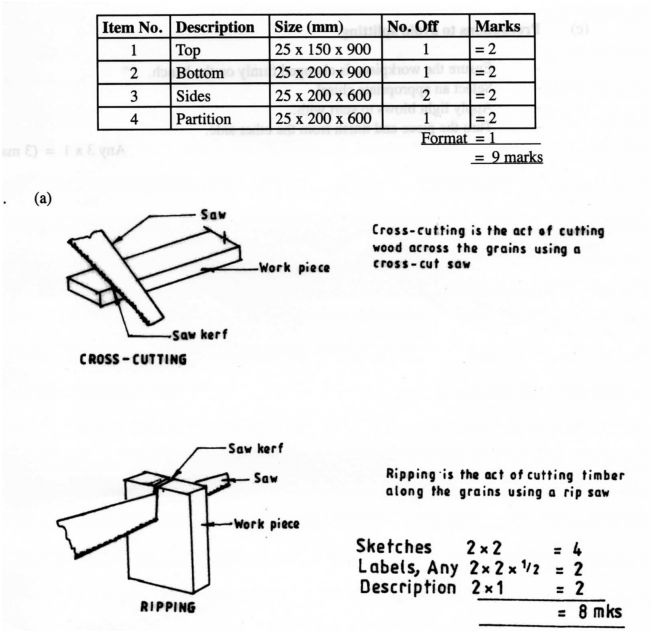
- Produces decorative radial face.
- Produces timber appropriate for joists.
Any 2 x1 = (2 marks)
Disadvantages
- Expensive form of conversion.
- Creates a lot of waste.
- Ideal for large logs.
Any2xI = (2marks)
Total = 4 marks
c) Precautions to avoid splitting.
- Ensure the workpiece is clamped firmly on the bench.
- Select an appropriate chisel.
- Apply light blows to start with.
- Tum the piece and finish from the other side.
Any 3 x 1 = (3 marks)
Kenya Scholarships for Undergraduate Students » Kenya Scholarships for Postgraduate Students » Undergraduate Scholarships for Kenyan Students » Kenya Undergraduate Scholarships » Full Undergraduate Scholarships for Kenyans » Kenya Postgraduate Scholarships » Scholarships & Grants » Undergraduate Scholarships » Universities in Kenya » Kenya Universities and Colleges Central Placement Service (KUCCPS) » Colleges in Kenya » KASNEB Registration & Results » Secondary Schools Scholarships in Kenya » Undergraduate & Graduate Scholarships for Kenyans
Scholarships for African Students » Undergraduate Scholarships » African Women Scholarships & Grants » Developing Countries Scholarships » Erasmus Mundus Scholarships for Developing Countries » Fellowship Programs » Funding Grants for NGOs » Government Scholarships » LLM Scholarships » MBA Scholarships » PhD and Masters by Research Scholarships » Public Health Scholarships - MPH Scholarships » Refugees Scholarships » Research Grants » Scholarships and Grants
Scholarships in Australia » Scholarships in Belgium » Scholarships in Canada » Scholarships in Germany » Scholarships in Italy » Scholarships in Japan » Scholarships in Korea » Scholarships in Netherlands » Scholarships in UK » Scholarships in USA
Scholarship 2025/26
Current Scholarships 2025/2026 - Fully FundedFull Undergraduate Scholarships 2025 - 2026
Fully Funded Masters Scholarships 2025 - 26
PhD Scholarships for International Students - Fully Funded!
Funding Opportunities for Journalists 2025/2026
Funding for Entrepreneurs 2025/2026
***
